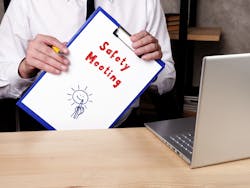So often in safety meetings and job briefings, the communication comes from one active participant to others who are all passive. A foreman runs a safety meeting and talks about this or that while half the attendees are barely paying attention. During a job briefing, the speaker rambles a bit, and people tune him out.
Imagine a safety meeting or a job briefing in which each person is responsible for sharing some aspect of the information — or, if that is impractical, a member or two of the crew handles part of the presentation.
For example, Foreman Frank is in charge of the job, so per NFPA 70E 110.1(I), he must provide a job briefing. This is not something he can do without preparing for it. Preparation takes time. So, he tells Aaron and Bob to write up a list of the individual tasks involved; they will inform the group about these tasks at the job briefing, and Frank will assign the tasks. Frank then tells Charlie and Dan they need to review all the work procedures involved and identify the special precautions. They will describe these at the meeting.
Foreman Frank will handle all the other aspects of the job briefing, and he will review with these guys what they intend to present before the briefing takes place.
Of course, these four crew members are being pulled off tools to do this work, so no time is really saved versus having Frank do it all. The benefit here is there are four more people who are much more engaged than they otherwise would be. It can help to rotate duties around. Maybe next time, Aaron and Erica will write up a list of the individual tasks involved while Charlie and Harry review the work procedures.
About the Author

Mark Lamendola
Mark is an expert in maintenance management, having racked up an impressive track record during his time working in the field. He also has extensive knowledge of, and practical expertise with, the National Electrical Code (NEC). Through his consulting business, he provides articles and training materials on electrical topics, specializing in making difficult subjects easy to understand and focusing on the practical aspects of electrical work.
Prior to starting his own business, Mark served as the Technical Editor on EC&M for six years, worked three years in nuclear maintenance, six years as a contract project engineer/project manager, three years as a systems engineer, and three years in plant maintenance management.
Mark earned an AAS degree from Rock Valley College, a BSEET from Columbia Pacific University, and an MBA from Lake Erie College. He’s also completed several related certifications over the years and even was formerly licensed as a Master Electrician. He is a Senior Member of the IEEE and past Chairman of the Kansas City Chapters of both the IEEE and the IEEE Computer Society. Mark also served as the program director for, a board member of, and webmaster of, the Midwest Chapter of the 7x24 Exchange. He has also held memberships with the following organizations: NETA, NFPA, International Association of Webmasters, and Institute of Certified Professional Managers.
